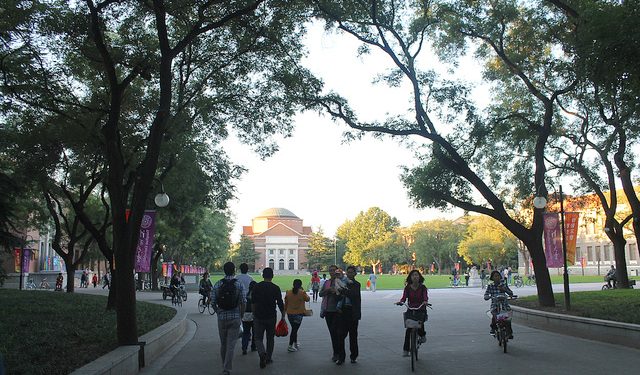Asia/China/21 de Agosto de 2016/Autor:Beckie Smith/Fuente: The Pie News
RESUMEN: El documento titulado, Lineamientos sobre Obras en la apertura del sector Educación en la Nueva Era, expone las intenciones del gobierno para fortalecer la imagen de China como un destino atractivo para estudiar, mejorar la calidad de la prestación de la educación internacional, y fomentar las asociaciones con las instituciones de educación extranjera y la empresa. Hay poca discusión en particular de estudio autofinanciado en el extranjero, ya que el documento pone un fuerte énfasis en la cooperación transfronteriza con universidades extranjeras y otras organizaciones. En profundidad la cooperación educativa entre ciudades hermanas en el extranjero y las instituciones; impulsar la calidad de los cursos de aprendizaje a partir de las universidades en el extranjero; y la participación en la investigación conjunta son algunos de los objetivos del plan que conducen hasta el año 2020. El gobierno va a desempeñar un papel en la facilitación de consulta de alto nivel sobre la educación y la cooperación. China IES y centros de formación profesional por su parte serán animados a invertir en el desarrollo de programas educativos o sucursales en el extranjero, así como establecer acuerdos de colaboración con la industria. El gobierno dice que va a dar prioridad al fortalecimiento de la cooperación con otros países del BRIC y el apoyo a los países en desarrollo a través de centros de educación y formación internacionales.
There are no surprises in the Chinese government’s latest plan for the country’s international education sector, stakeholders have said, as the blueprint, which aligns with the country’s current Five Year Plan, reflects a shift in focus to be more outward looking.
The document, entitled Guidelines on Works in Opening Up the Education Sector in the New Era, lays out the government’s intentions to strengthen China’s image as an attractive study destination, boost the quality of international education provision, and encourage partnerships with foreign education institutions and enterprise.
There is notably little discussion of self-funded study abroad, as the document places a heavy emphasis on cross-border cooperation with foreign universities and other organisations.
In-depth educational cooperation between overseas sister cities and institutions; boosting course quality by learning from overseas universities; and engaging in joint research are among the plan’s goals leading up to 2020. The government will play a role in facilitating high-level consultation on education and cooperation, it states.
Chinese HEIs and vocational colleges meanwhile will be encouraged to invest in developing educational programmes or branches overseas, as well as establish partnerships with industry.
The focus on foreign partnerships may encourage Chinese HEIs that have been uncertain about developing partnerships with overseas institutions to do so.
“The biggest positive would be any Chinese institution that has been reluctant to pursue foreign partnerships would, in light of this statement, be having another think about doing so,” said Kim Morrison, CEO at market entry specialists Grok Global Services.
The document does not contain any surprises for stakeholders but is “representative of the direction China is taking overall – gradually opening up, inviting more foreign investment, spending more on science and technology, exposing youth to overseas cultures and experiences”, according to Morrison.
The government says it will place priority on strengthening cooperation with other BRIC countries and supporting developing countries through international education and training centres.
Emphasis will also be put on promoting the ‘Study in China’ brand to attract more inbound international students.
In particular, the strategy aims to target overseas talent from specific groups including speakers of less-common languages, specialists for international organisations and top visiting scholars.
The government also intends to overhaul the country’s TNE programme by reforming the programme approval and withdrawal and accreditation procedures.
The policy has the potential to be a “valuable resource in terms of understanding the country’s priorities in the field of international education cooperation over the current five-year plan period”, noted Davisson Li, education marketing officer at the British Council in China.
But Li also pointed out that the document does not set out specific timelines for the reforms listed.
The proposed TNE reforms in particular “will likely make these procedures and requirements clearer and therefore be a positive development for [foreign] institutions interested in joint provision in China”, he added, although they are non-specific in nature.
On the outbound side, of which there is scant mention, the strategy promises to ramp up oversight of education agencies – though again, it does not outline any specific measures.
Further discussion of how the country can promote outbound study or support self-funded students is conspicuously absent from the plan, said Peng Sang, president of the Beijing Overseas Student Services Association.
“As in the past, the document which has just been issued by the Ministry of Education shows a great concern and positive promotion of education,” Sang commented. “However, it hasn’t discussed the topic of students studying abroad at their own expense at all, nor anything about the future expectation.”
Fuente: http://thepienews.com/news/china-releases-outward-facing-international-education-strategy-to-2020/







 Users Today : 35
Users Today : 35 Total Users : 35460244
Total Users : 35460244 Views Today : 43
Views Today : 43 Total views : 3418938
Total views : 3418938